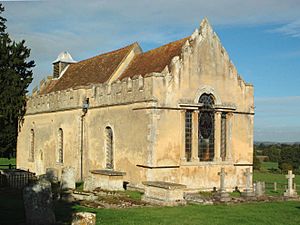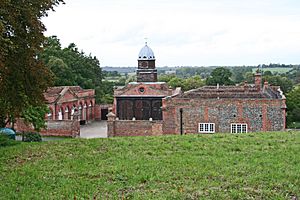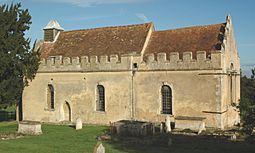Wheatfield, Oxfordshire facts for kids
Quick facts for kids Wheatfield |
|
|---|---|
 St. Andrew's parish church |
|
| Population | 22 (2001 census) |
| OS grid reference | SU6899 |
| Civil parish |
|
| District | |
| Shire county | |
| Region | |
| Country | England |
| Sovereign state | United Kingdom |
| Post town | Thame |
| Postcode district | OX9 |
| Dialling code | 01844 |
| Police | Thames Valley |
| Fire | Oxfordshire |
| Ambulance | South Central |
| EU Parliament | South East England |
| UK Parliament |
|
Wheatfield is a small area in Oxfordshire, England. It is known as a civil parish, which is a local government area. It was once a busy village but is now a deserted medieval village, meaning most people moved away a long time ago.
The name "Wheatfield" comes from old English words meaning "white field." This likely referred to the ripe crops, like wheat, that grew there. Today, only a few buildings remain. These include the Church of England parish church of Saint Andrew, the old rectory (where the church leader lived), and some buildings that used to belong to the manor house.
Contents
Wheatfield's History: The Manor
Wheatfield was first mentioned in 1086 in the Domesday Book. This was a huge survey ordered by King William the Conqueror. It recorded who owned land and what it was worth. The Domesday Book shows that a person named Robert D'Oyly owned the "manor" of Wheatfield. A manor was a large estate with a lord, land, and villagers.
Over time, Wheatfield became part of the "Honour of Wallingford," a big group of lands. A family called De Whitfield owned the manor for many years. But in 1390, the last male heir died. The manor was then split between two daughters.
The Tipping Family Takes Over
By 1576, a man named Thomas Tipping bought both halves of Wheatfield. This reunited the manor under one owner. His grandson, William 'Eternity' Tipping, was born and baptized in Wheatfield.
Later, important members of the Tipping family owned the estate. This included Sir Thomas Tipping, who supported Parliament during the English Civil War. Another Sir Thomas Tipping was made a baronet (a special title) by King William III in 1698. The Tipping family faced money problems and eventually had to sell Wheatfield.
New Owners and a "Squarson"
John Rudge, a Member of Parliament, bought Wheatfield in 1727. After his son died without children, Wheatfield was sold again in 1769. Lord Charles Spencer, from a very important family, became the new owner.
Interestingly, one later owner, Charles Vere Spencer, was a "squarson." This meant he was both the lord of the manor (the main landowner) and the parson (the church leader) for the area. The Spencer family still owned Wheatfield in the 1960s.
The Manor House and Wheatfield Park
The Tipping family built a large manor house in the late 1500s or early 1600s. It was located near St. Andrew's church. Records show it was a very big house with many rooms. In 1662, it had 15 hearths (fireplaces), which meant it was a huge building for its time.
The house was rebuilt in the 1700s, likely for John Rudge. This new house was in the Georgian style and was called Wheatfield Park. It had beautiful gardens, a fountain, and a pond.
After Lord Charles Spencer bought the manor, he made the house even bigger. But on New Year's Day in 1814, a terrible fire broke out. Fire engines tried to help, but the water was frozen because of a severe frost. French prisoners of war, who were in the area, even helped fight the fire. The French officer suggested blowing up part of the house to save the rest, but Lord Charles Spencer refused. He worried about the safety of the people and the church.
The main house was destroyed, but some other buildings survived. These included the stables, coach-house, and a farmhouse. These buildings are still standing today and are considered important historical structures.
St. Andrew's Parish Church
Wheatfield has had a church since at least 1202. The oldest parts of Saint Andrew's church are from the 1300s. These include an arch and a doorway. The roof is likely from the 1600s.
In the 1700s, John Rudge had the church updated. This gave it a Georgian look, but some older parts remained. The church still has its 1700s features, like a special east window and old wooden box pews (enclosed seats). The wooden communion table is a beautiful carved piece from around 1745.
Church Monuments and Features
Inside St. Andrew's, you can find monuments from the 1600s and 1700s. These honor members of the families who owned the manor. One monument to John Rudge was made by a famous sculptor named Peter Scheemakers.
The church also has old stained glass windows. Some show the coats of arms of the Whitfield family from the 1300s. Others show the arms of the Rudge and Letten families from the 1700s. The east window has beautiful stained glass from the late Victorian era by Morris & Co..
St. Andrew's church does not have a tall tower. Instead, it has a small bell-turret with one bell, cast in 1636. The church has no running water or electricity. It is lit only by candles on old brackets. St. Andrew's is a very important historical building, known as a Grade I listed building.
In 1729, John Rudge gave the church a set of special plates and cups for services. These were kept at Wheatfield Park for safety. Sadly, they were destroyed in the 1814 fire. Lord Charles Spencer then gave the church a new set in 1814. Today, St. Andrew's church is part of a larger group of churches, including those in Thame and Lewknor.
The Old Rectory, Now Wheatfield House
In the 1600s, Wheatfield had a large Rectory, the house where the church's rector lived. It was rebuilt in the early 1700s. Later, in 1823, a new rector, Frederick Charles Spencer, updated and extended the house. He added a Doric porch, but kept the Queen Anne style look of the front.
In the 1900s, the house stopped being the Rectory. In 1928, it was sold to the lord of the manor, Aubrey Vere Spencer. He renamed it Wheatfield House and made it the new manor house.
Wheatfield's Community Life
For many years, Wheatfield was a successful farming community. By 1212, it even had a watermill. Records from 1279 show that there was a lot of farmland. The village supported at least 12 villeins (peasants who worked the land) and two freeholders, as well as the Lord of the Manor and the Rector.
The community recovered well after the Black Death in the 1300s. By 1377, about 60 adults lived in the parish. However, in 1505, the lord of the manor, John Streatley, enclosed 160 acres of farmland. This meant he turned it into pasture for animals, which left 54 peasants without land or homes. The population then dropped a lot. The mill was no longer needed and stopped being used by 1574.
Some open fields remained, and a small number of peasants stayed in Wheatfield. In 1662, records show seven households besides the Manor House and the Rectory.
Population Changes and Education
The population of Wheatfield changed a lot over the years. In 1801, there were 89 people, and in 1831, it reached 105. But after that, the population started to fall again. By 1901, there were 72 people, and in 2001, only 22 inhabitants were recorded.
Because Wheatfield had so few children, it was hard to support a school. In 1784, poor children received schooling through donations. A Sunday school started in 1790, but it eventually closed. A dame school (a small private school) opened in 1824, teaching a few boys and girls. By 1854, it only had six students and then closed.
After that, children from Wheatfield went to schools in nearby villages like Lewknor and Stoke Talmage. In the 1950s and 60s, Wheatfield children attended schools in Tetsworth and then Watlington.




